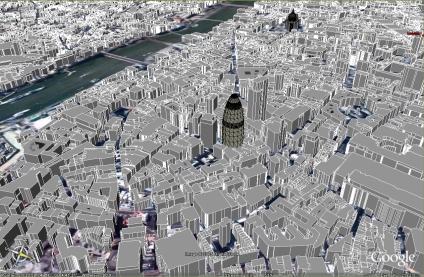ThinkLemon’s been working on this for a while, and now his KML lists of impact structures have become quite the resource. Another must-have, for schools as well.
Pre-emptive post
An article in Times of India today begins thus: “Legally, you aren’t supposed to come within arm’s length of India’s military bases…” You already know what it’s about. (Article reposted here.)
Did Indian bloggers revel in the fact that they finally had free access to military secrets previously privy only to Pakistan and other nations with military satellites? Not at all. Race for Perfection has no Finish Line is the most sanguine, mentioning in passing that this news has meanwhile made it to Indian TV. Google Earth is “in trouble” according to this blogger, and “this kind of tool can be a boon to the people involved in anti social activities.”
Vasanth Dharmaraj’s Blogs writes “I read in the local newspaper that Google Earth reveals all the vital defense units located in Bangalore. Hopefully the authorities contact Google to blur them.”
Why? Why hopefully? And finally, Shwetanshu’s Blog writes:
Google Earth creates tension as Indian sensitive areas such as INS Viraat docked at Mumbai, IAF Bases and Rashtrapati Bhawan to name a few are clearly shown, whereas the White House is missing from the map.
Sigh. Doesn’t anyone factcheck anymore, or is it true if you’ve read it in a blog?
The problem is that India and Pakistan are still emprisoned in a kind of cold war thinking that previously gripped the US and USSR. Snap out of it already — there is nothing in Google Earth that Pakistan doesn’t already know. if Google Earth makes you feel vulnerable, that’s because everybody is when two nuclear powers antagonize one another.
Watch this space for the reaction by politicians, tomorrow.
View scales for WMS in Google Earth
Chris’s PHP script for viewing WMS data in Google Earth keeps on getting better. He’s added a feature that can determine whether or not to show a layer, depending on your level of zoom.
Kismet => Google Earth
More geeky goodness: If you use Kismet to sniff out wifi networks, you’ll appreciate Philippe Niquille’s Kismet Earth, a PHP script that converts Kismet logs to KML files, ready for Google Earth.
Sharing the Google Earth cache
For sysadmins, a handy primer on how to share the Google Earth chache with others at the office using Squid Web Proxy Cache. (I haven’t tested this, obvs.)
Garmin’s MapSource supports Google Earth
Just noticed that the latest Beta builds of the Garmin MapSource software support Google Earth natively. (Via)
3D London redux

Um, wow. Could Dr Andrew Hudson-Smith and Google Earth please talk?